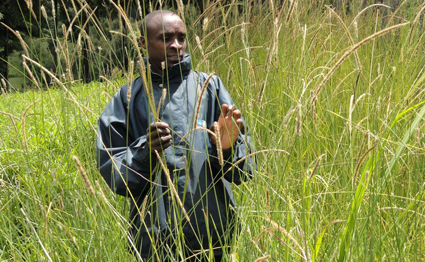
Make hay while the sun shines! While this often quoted adage is true in life when one encouraged to take advantage of good prevailing conditions, in hay making the adage is paradoxical.
This is because while we indeed need dry weather to make Rhodes Grass hay, we need rainy conditions and well enriched soils to produce the quality grass that makes the quality hay.
Therefore since grass production precedes hay making, hay producers should aim for the highest quality grass which benefiting from sunny baling days, will give them quality hay that will not only be preferred by customers but will also give them good returns.
Paying attention to soil fertility is one major area in which we can influence the quality of our grasses and hence hay. Hay making removes a lot of nutrients, particularly Nitrogen from the soil and if it is not frequently replenished as top dressing, the grass becomes poor – both in yield per acre and in nutritive value.
Ideally one should do a comprehensive soils test to know the exact nutrient deficiency in the farm, the appropriate fertilizers to apply and the rates of application. The Rhodes Grass crop (field) history though it should not replace soil testing, can also be used in determining the topdressing regime to use. E.g. Is the crop the 1st from a virgin land or is it immediately after a heavily fertilized crop?
Top dressing Rhodes Grass with Nitrogenous (N) based fertilizers has been a big game changer in our grasses. In every season we see the prudence of top dressing because there is positive change in grass density, height, growth rate and color.
RELATED CONTENT: Accountant earns double from dairy and hay production after quitting job
On the quality side, the feedback from our hay customers confirms to us that top dressing and keeping our soils in good fertility helps to transfer the nutrient richness to the hay and the response from their animals vindicates this.
It is also on this basis that I am constantly reminding farmers that in the absence of credible hay tests, the next best alternative they have of assessing the quality of hay is by seeing the grass actively growing in the field. Remember with all animal feeds the NINO rule reigns: Nutrients In, Nutrients Out – so even if the hay was baled when the sun was shining, if the grass did not have enough nutrients then the hay is just stomach filler.
Timing of top dressing with Nitrogenous based fertilizers is important. It should be done when the grass is actively growing since this is the stage at which its Nitrogen need is high and there is maximize utilization of the applied fertilizer leading to an accelerated growth rate and increased grass yields.
RELATED CONTENT: Graduate earns about Sh1m a season from hay production after leaving Sh10,000 salary job
There should be enough moisture in the soil to make the fertilizer dissolve quickly and be available in the grass root zone – this increases nutrient efficiency. Since this will trigger a flush of new growth there should also be forecasted rainfall so that water does not become the limiting factor when the nutrients are available.
Rainfall can also complicate the timing because one should avoid top dressing with Nitrogenous fertilizers when there are excessive rains due to nitrogen leaching. This is the situation in which the nitrogen is drawn down below the root zone of the grass making it unavailable to the grass.
Particularly for Rhodes Grass producers in ASALs, timing of fertilizer application can be the decider on if you will have a good grass season or not.
RELATED CONTENT: Kiambu farmers access year round low cost hay
If using fertilizer spreaders to top dress, the period with excessive rains is one to be watchful for because it can result in damaging the soils by leaving deep tractor ruts in the farm which will be a problem during other hay making, particularly in raking.
At Lukuai Farm, even though we don’t do our top dressing applications in truly research settings, we deliberately leave a non-applied section for comparing results and also to use for on the farm training. We have obtained best results in the fields where we have top dressed with organic manure in prior seasons and then used Urea – as the Nitrogenous top dressing.
For consultation on topdressing of Rhodes Grass and hay production training at Lukuai, contact the blog writer:
Anne, Tel: 0725-520627
Email: This email address is being protected from spambots. You need JavaScript enabled to view it.
















Comments powered by CComment